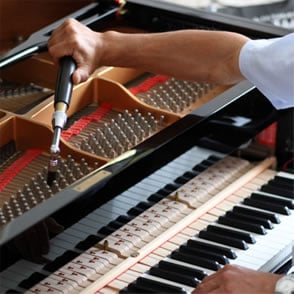 backframe of your vertical piano. Some manufacturers have taken to using half-size posts on the ends and these half-size posts will not provide a piano with the same tuning stability as full-size posts will.
backframe of your vertical piano. Some manufacturers have taken to using half-size posts on the ends and these half-size posts will not provide a piano with the same tuning stability as full-size posts will.
We also have several concerns about another new vertical piano construction "short cut" some manufacturers have begun using — the short post. Like half-size posts, the short post compromises a piano’s overall integrity and will not provide the same kind of long-term tuning stability a higher quality grand piano will have.
When you look at the backframe of a vertical piano, you should see six posts running from the top to the bottom of the piano’s backframe. In high quality pianos, these posts run up into the frame itself either in a mortise and tenon joint — a strong, sturdy carpentry joint — or with filler blocks cut, laminated, fitted and glued between the posts across the top and bottom of the backframe. Either of these construction methods means the posts provide superior support for the pinblock, where the strings attach to the tuning pins. The posts, frame and pinblock together have to support at least 20 tons of string tension. The stronger the construction, the more stable the piano.

Pianos that lack good piano tuning stability will cost you much more over the years in tuning costs and you may also notice a difference in overall sound quality. Your piano could also suffer from structural damage to the backframe over time as less stable frames tend to twist and warp more easily. Ultimately, your piano won’t last as long and will have a much lower value over time.
A piano is one purchase where you don’t want to accept short cuts in manufacturing. Sure, these pianos might cost less up front, but over time, the investment won’t pay off. Instead, know what to look for in your piano’s backframe.






